Genus AbramisCuvier, 1816 Higher classification Abramis Conservation status Least Concern | Phylum Chordata Scientific name Abramis brama Mass 3.3 kg (Adult) Rank Species | |
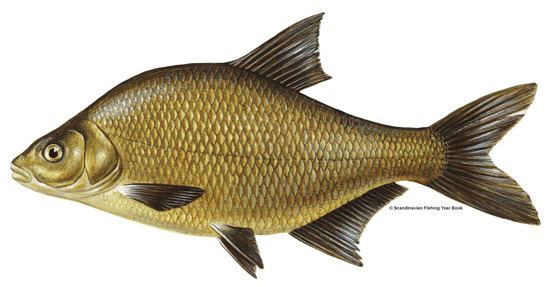 | ||
Similar Common roach, European perch, Zander, Northern pike, Tench | ||
The common bream, freshwater bream, bream, bronze bream or carp bream (Abramis brama), is a European species of freshwater fish in the family Cyprinidae. It is now considered to be the only species in the genus Abramis.
Contents
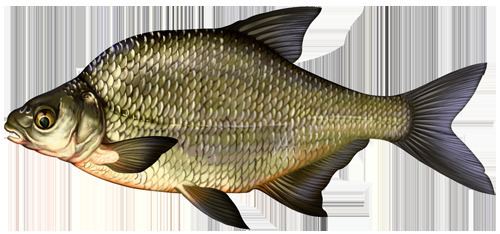
Range and habitat
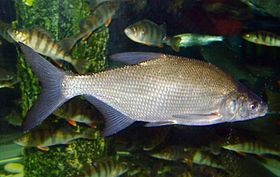
The common bream's home range is Europe north of the Alps and Pyrenees, as well as the Balkans. It is found as far east as the Caspian Sea, the Black Sea, and the Aral Sea. The common bream lives in ponds, lakes and canals, and in slow-flowing rivers.
Description
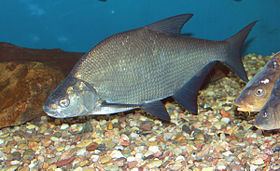
The bream is usually 30 to 55 cm (12 to 22 in) long, though some specimens of 75 cm (30 in) have been recorded; it usually weighs 2 to 4 kg (4.4 to 8.8 lb). The maximum length is 90 cm (35.5 in) with a maximum recorded weight of about 9.1 kg (20 lb).
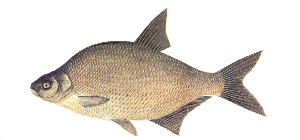
It has a laterally flattened and high-backed body and a slightly undershot mouth. It is a silvery grey colour, though older fish can be bronze-coloured especially in clear waters. The fins are greyish to black, but never reddish.
Similar-looking fish
The common bream can easily be confused with the silver or white bream (Blicca bjoerkna), in particular at the younger stages (see picture). The most reliable method of distinguishing these species is by counting the scales in a straight line downwards from the first ray of the dorsal fin to the lateral line. Silver bream have fewer than 10 rows of scales, while common bream have 11 or more. At the adult stage the reddish tint of the pectoral fin of the silver bream is diagnostic. Like other Cyprinidae, common bream can easily hybridise with other species, and hybrids with roach (Rutilus rutilus) can be very difficult to distinguish from pure-bred bream.
Habitat
The common bream generally lives in rivers (especially in the lower reaches) and in nutrient-rich lakes and ponds with muddy bottoms and plenty of algae. It can also be found in brackish sea waters.
Feeding habits
The common bream lives in schools near the bottom. At night common bream can feed close to the shore and in clear waters with sandy bottoms feeding pits can be seen during daytime. The fish's protractile mouth helps it dig for chironomid larvae, Tubifex worms, bivalves, and gastropods. The bream eats water plants and plankton, as well.
In very turbid waters, common bream can occur in large numbers, which may result in a shortage of bottom-living prey such as chironomids. The bream are then forced to live by filter feeding with their gill rakers, Daphnia water fleas being the main prey. As the fish grows, the gill rakers become too far apart to catch small prey and the bream will not then grow bigger than 40 cm (16 in). If a common bream is malnourished, it can develop a so-called "knife back", a sharp edge along its back.
Spawning
The common bream spawns from April to June, when water temperatures are around 17 °C (63 °F). At this time, the males form territories within which the females lay 100,000 to 300,000 eggs on water plants. The fry hatch after three to 12 days and attach themselves to water plants with special adhesive glands, until their yolk is used up.
Because of their slender shape, the young fish are often not recognised as bream, but they can be identified by their flat bodies and silvery colour. At this stage, the fish are still pelagic, but after a few months, they acquire their typical body shape and become bottom-dwellers. By three to four years old, the fish are sexually mature.
Fishing
They are fished both commercially and for sport.
However, bream do not often fight as hard as some other species native to the UK, and owing to their flat, disc-shaped profile, once tilted to one side, are relatively easy to bring to the bank. Common baits for bream include:
All three methods can be fished using a paternoster rig, and cage feeder with the bait, for example sweetcorn fixed inside using groundbait plugs, or maggot feeder when fishing maggots.
